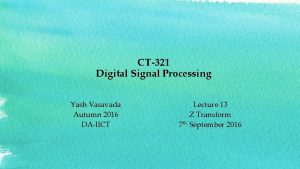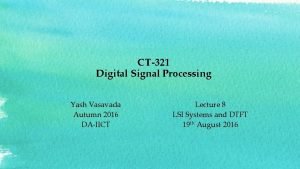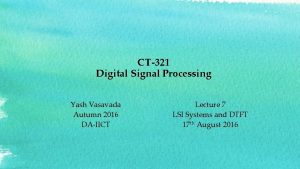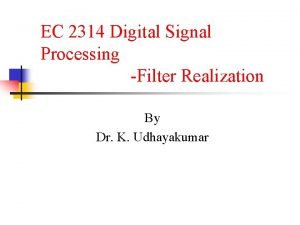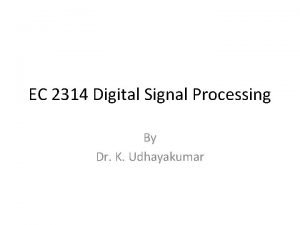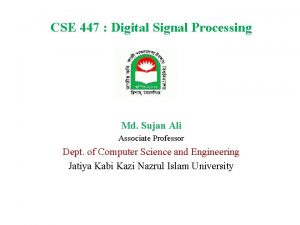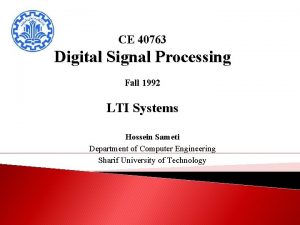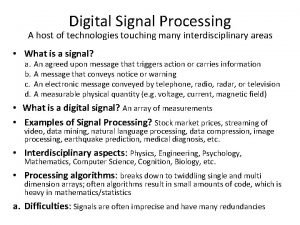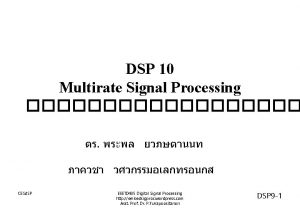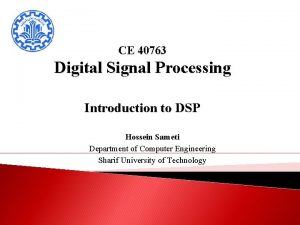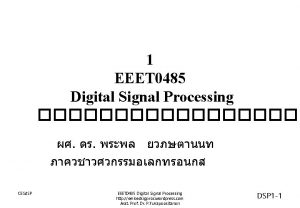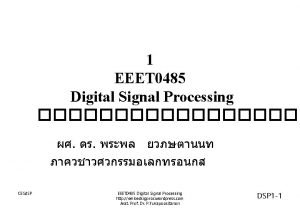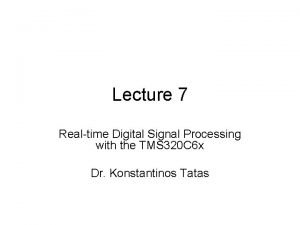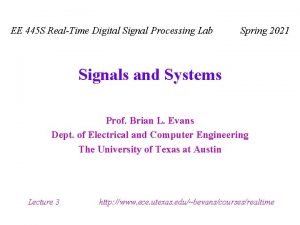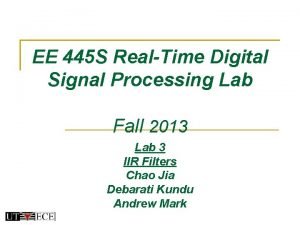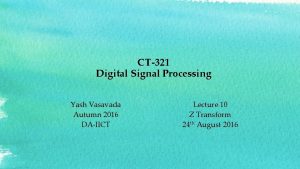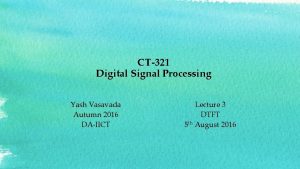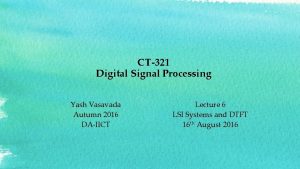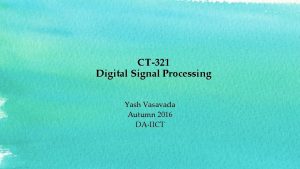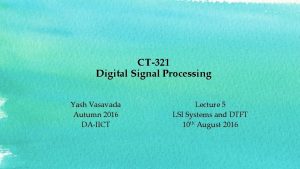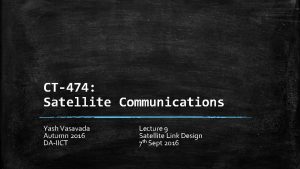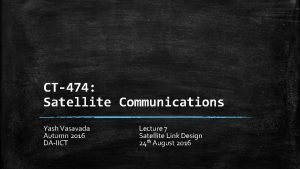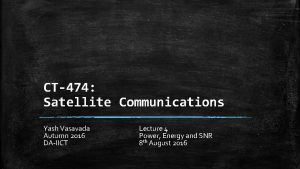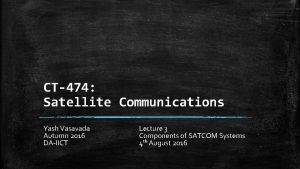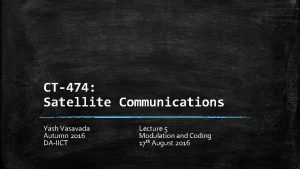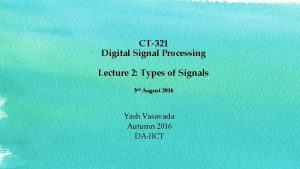CT321 Digital Signal Processing Yash Vasavada Autumn 2016


















- Slides: 18

CT-321 Digital Signal Processing Yash Vasavada Autumn 2016 DA-IICT Lecture 4 LSI Systems and DTFT 9 th August 2016

Review and Preview • Yash Vasavada DA-IICT. Autumn 2016 CT-321. Lecture 4: 9 th August 2016. 2

Preview and Reading Assignment • Preview of this lecture: – Linear Time Invariant (LTI) Systems – Relation to DTFT • Reading Assignment – OS, 3 rd Edition: Sections 1. 2 to 1. 4, and Sections 1. 6 to 1. 9 • Note: available in the library – PM: Sections 2. 1 to 2. 3 Yash Vasavada DA-IICT. Autumn 2016 CT-321. Lecture 4: 9 th August 2016. 3

Review of Past Lecture: Rectangular Window Function • Rectangular pulse is a key signal of frequent application in theoretical DSP studies • To see why, consider a hypothetical signal that we have received, that has an undesired component mixed in with the desired signal. We want to get rid of the unwanted component. • One solution is to multiply this received signal by a rectangular pulse of unity amplitude and of sufficient width centered at the desired signal’s location. – This will zero out the unwanted component and leave the desired part unchanged. – This operation is also called rectangular windowing • Notice that this mixture of desired and unwanted signals can occur either in time domain or in frequency domain • In time domain, it’s not hard to envision implementation of the multiplication operation between the received signal and the rectangular pulse. However, how to do so in the frequency domain? 1 Unwanted 0 Yash Vasavada Desired Time or Frequency DA-IICT. Autumn 2016 CT-321. Lecture 4: 9 th August 2016. 4

Review of Past Lecture: Averaging of Multiple Samples of Complex Phasor • • Surprisingly quite similar to the Fourier Transform of the rectangular pulse in continuous time domain! • Why? Now solve using this expression: Yash Vasavada DA-IICT. Autumn 2016 CT-321. Lecture 4: 9 th August 2016. 5

Discrete Time Fourier Transform • Yash Vasavada DA-IICT. Autumn 2016 CT-321. Lecture 4: 9 th August 2016. 6

Recap • Yash Vasavada DA-IICT. Autumn 2016 CT-321. Lecture 4: 9 th August 2016. 7

DTFT of the Rectangular Pulse • Frequency domain representation becomes localized (is narrower) as the time domain signal spreads out (becomes wider) Time Domain Rectangular Pulses DTFT (Frequency Domain Representation of Rectangular Pulses) – Same as the observation we have made earlier in context of C-T signals • Can DTFT be reversed? – i. e. , can the discrete time samples be recovered from continuousfrequency DTFT? – If so, what is likely to be this “inverse” DTFT of rectangular function in the frequency domain? Yash Vasavada DA-IICT. Autumn 2016 CT-321. Lecture 4: 9 th August 2016. 8

Inverse DTFT • Time Domain: Discrete Samples Yash Vasavada DA-IICT. Autumn 2016 Frequency Domain (Continuous and Periodic) CT-321. Lecture 4: 9 th August 2016. 9

Why DTFT is Important? • Recall our conundrum earlier: how to multiply any signal with another signal (say, a rectangular window function) in frequency domain? • Armed with the tool of DTFT, we are now in a position to begin to solve this puzzle Yash Vasavada DA-IICT. Autumn 2016 CT-321. Lecture 4: 9 th August 2016. 10

Digital Signal Processing Systems • Yash Vasavada DA-IICT. Autumn 2016 CT-321. Lecture 4: 9 th August 2016. 11

Digital Signal Processing Systems: Some Key Properties • Yash Vasavada DA-IICT. Autumn 2016 CT-321. Lecture 4: 9 th August 2016. 12

Digital Signal Processing Systems: Some Key Properties • Consider the two systems A and B shown below Yash Vasavada DA-IICT. Autumn 2016 CT-321. Lecture 4: 9 th August 2016. 13

Digital Signal Processing Systems: Some Key Properties • Yash Vasavada DA-IICT. Autumn 2016 CT-321. Lecture 4: 9 th August 2016. 14

Digital Signal Processing Systems: Some Key Properties • Yash Vasavada DA-IICT. Autumn 2016 CT-321. Lecture 4: 9 th August 2016. 15

Impulse Response of Linear Shift Invariant Systems • Yash Vasavada DA-IICT. Autumn 2016 CT-321. Lecture 4: 9 th August 2016. 16

Output of Linear Shift Invariant Systems as a Function of Impulse Response and the Input • Yash Vasavada DA-IICT. Autumn 2016 CT-321. Lecture 4: 9 th August 2016. 17

Output of Linear Shift Invariant Systems as a Function of Impulse Response and the Input • Yash Vasavada DA-IICT. Autumn 2016 CT-321. Lecture 4: 9 th August 2016. 18
 Yash vasavada
Yash vasavada Yash vasavada
Yash vasavada Yash vasavada
Yash vasavada Digital signal as a composite analog signal
Digital signal as a composite analog signal Digital signal processing
Digital signal processing Advantages of dsp
Advantages of dsp Digital signal processing
Digital signal processing Digital signal processing
Digital signal processing Complex wave
Complex wave Digital signal processing
Digital signal processing Digital signal processing
Digital signal processing Image processing
Image processing Digital signal processing
Digital signal processing What is digital signal processing
What is digital signal processing What is digital signal processing
What is digital signal processing Z domain to frequency domain
Z domain to frequency domain High-performance digital signal processing
High-performance digital signal processing Digital signal processing
Digital signal processing Yashpal committee learning without burden
Yashpal committee learning without burden
